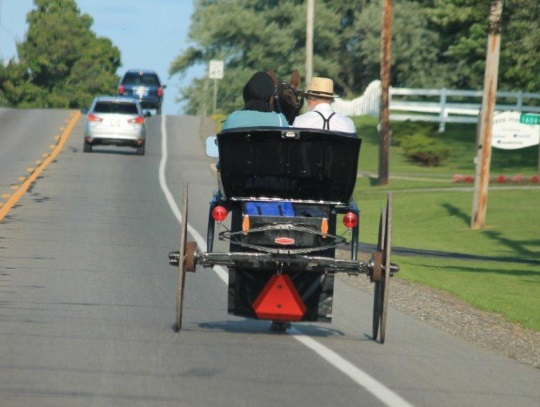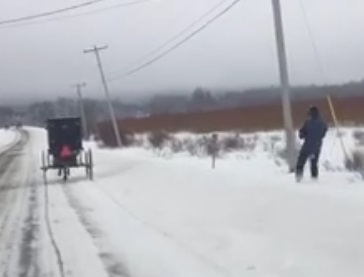Geauga County To Get $14 Million in Road Safety Improvements
This story landed over Christmas, so might have gone overlooked. The AP reports good news for horse-and-buggy drivers and their neighbors in northeast Ohio:
 MIDDLEFIELD, Ohio (AP) — Work to widen roads and make other safety improvements is planned in an area of Ohio’s Amish country plagued by crashes resulting in injuries, according to federal and state officials.
MIDDLEFIELD, Ohio (AP) — Work to widen roads and make other safety improvements is planned in an area of Ohio’s Amish country plagued by crashes resulting in injuries, according to federal and state officials.
The U.S. Department of Transportation and the Ohio Department of Transportation said they are teaming up on the $14 million project in northeastern Ohio’s Geauga County.
The Northeast Ohio Areawide Coordinating Agency said the plan involves widening roads, posting signs, educating travelers and taking many other steps to make the Middlefield area safer for pedestrians, buggy riders and motorists.
A $9.6 million grant from the U.S. Department of Transportation was awarded to coordinating agency to help fund the safety improvements, and federal officials said they will partner with the state to fund the remainder.
Geauga County is home to the fourth-largest Amish settlement, and Middlefield is at its heart. Like Pennsylvania, a state with a similar-sized Amish population, there have been dozens of crashes and numerous deaths in Ohio in recent years:
Many travelers are injured in crashes involving buggies each year in Ohio. Overall, Ohio State Patrol records show 860 crashes involving buggies from 2012-2017 in Ohio that killed 18 people and injured more than 720.
The Plain Dealer reported that one study found that there were 83 crashes with buggies from 2010 through 2014 in the Middlefield area alone. Three of those crashes were fatal, according to the study.
Ohio has over 75,000 Amish people. The state also has a small Old Order Mennonite population as well as Old Order German Baptist Brethren, both of whom use horse-drawn transportation.

Innovative safety enhancements
Construction is planned for 2020-2023. Interestingly, among the intended additions are “buggy detectors” along with improvements to warning systems in current school zones.
As far as “warning systems” it’s a bit unclear what they are referring to, and this might just refer to flashing lights in school zones.
However, I found a cached version of a 2016 ODOT document entitled “AMISH SAFETY STRATEGIC PLAN GEAUGA COUNTY” containing some interesting decriptions of a buggy detection system:
Amish buggy warning detection system (Cost Estimate: $20,000/location)
> Description: Most warning signs are static signs, and over time motorists become indifferent to these signs. This condition can be mitigated with an enhanced warning sign that is active when a conflict exists, (i.e., a detection system that can identify a slow-moving vehicle such as an Amish buggy), and activate the flashing sign to warn motorists of an Amish buggy presence. Higher luminance and better contrast attract motorists’ attention, leading to cautious driving when compared to a conventional static sign. Detection systems such as advanced radar are suggested. These detection systems are recommended for crest vertical curves, so that an Amish buggy on the downhill side is detected and a warning sign is activated on the uphill side, so drivers approaching the crest are informed of a slow-moving Amish buggy on the downhill side. This will allow drivers to slow down as they pass the crest. This treatment can also be applied to locations with winding curves.
• The Amish survey results show that going over hills or around curves with limited sight distance is the second biggest safety concern for horse drawn buggy travel. The actuated warning system will allow motorists to slow down proactively for a downstream slow-moving vehicle, especially at night.
It’s noted that this application is experimental, or at least was at the time of the report (2 and 1/2 years ago), but that there is some sort of precedent in the Aloha State:
• Note that this application would be experimental. No “off-the-shelf” systems are currently available. A preliminary equipment recommendation would include advanced radar detectors to detect slow moving vehicles, paired with a controller to activate the flashing warning sign and extend the flashing to a time period where the buggy is no longer in the zone with poor sight distance.
The State of Hawaii uses a similar concept to detect bicyclists within tunnels when they are on the roadway and not visible to vehicles entering the tunnel. This application is not complex and it is expected that engineers could complete the design. It is also possible that the detector and the warning beacon could be combined on the same support by using a delay in the algorithm to control the length of time the beacon is on.
Here’s another description of a flashing beacon system, including one variant which is triggered by the buggy:
Sounds like something that might be helpful if motorists understand how to act when the beacons are actuated. The document lists eight locations for the warning systems, ordered by priority.
What about “buggy detectors?” This might be referring to the above…or could be about remedying how existing traffic light systems fail to detect and trip the light for buggies:
Also sounds like a nice idea.
Assuming these descriptions in the document are accurate, it sounds like the improvements have been well-thought-through (there are many others listed, including lower-tech enhancements like additional signage, wider shoulders, and buggy pull-off lanes).
I’m not sure how much of what is contained in that 2016 document is included in the final plan (though it wouldn’t be surprising if a lot of it was). Either way, going by the general description in the AP article, this investment should lead to accidents avoided and lives saved, and may even use some innovative means to do so.
Photo credits: ShipshewanaIndiana






So clever, and so helpful (potentially) !
These proposals impress me. They seem well-thought-out and kindly intended. Neighbour helping neighbour, really — the best of us coming to the fore.
I was only able to read sections and skim the rest til now, but found the 2016 report to be pretty impressive in its scope. Looking forward to seeing what changes they implement and hopefully they are ones which make the greatest impact. Also particularly interested to see if and to what extent those warning systems I excerpted above are realized in the plan.
Road Improvements for Buggies and motor vehicles
These are great ideas that should’ve been implemented long ago. Where we live in Klamath Co. Oregon, there are barely shoulders on either side of the roads so anyone wanting to drive a buggy or carriage is at the mercy of speeding drivers on the road! Terrible! The county won’t even improve roads up where we live. Great job Ohio!
Poor Roads
The erstwhile Wisconsin Governor, Scott Walker, was never a friend of the Amish when it came to road improvements and maintenance. Southern Green Lake County always got short shrift when it came to infrastructure. The state couldn’t have cared less when allocating funding for road improvement in Green Lake County. I believe it is due to Amish reluctance to ‘make waves.’ It took English intervention (mine) to have the County erect school caution signs because County officials wouldn’t listen to the Amish.
For the past several years I’ve been trying – unsuccessfully – to have Green Lake County repave Lane 7 which is used by corporate farmers tearing it up with extremely heavy equipment – no problem negotiating the huge pot holes they create – rendering the lane almost unusable. The deplorable condition of this lane is responsible for numerous horse injuries and buggy problems. Hopefully, the new governor will see fit to allocate funds to Green Lake County so they can do something about the disgraceful conditions of the secondary and tertiary roads in southern Green Lake County…where so many of my good Amish friends live.
Ken I bet your friends in the Amish community appreciate it or would if they knew about it. I think you are right that Amish people in general are less inclined to make some noise which can be what it takes to get things like this done. I imagine this is the case especially in areas where Amish make up a smaller proportion of the population. Green Lake Co. has some Amish but nothing like Geauga County of course.
Elkhart County, IN to get buggy lanes
Elkhart County in northern Indiana will be getting some buggy lanes in addition to pre-existing lanes on state highways in the community. Installation of the lanes will begin by 2020.
https://www.wibc.com/news/local-news/elkhart-county-plans-install-buggy-lanes-county-roads
ELKHART COUNTY, Ind. — Commissioners in Elkhart County are moving forward with a plan to install buggy lanes on a couple busy county roads.
The project would put an exclusive lane on these county roads specifically for horse and buggies, which are used to get around by a majority of the county’s Amish community. County commissioner Mike Yoder said they are getting some help from the federal government on the project.
The state already has buggy lanes on state highways in high Amish population areas such as Parke, LaGrange, and Elkhart Counties.
About time
Glad to hear there has been some attention but I am pessimistic. That area is a favorite for a day trip from W.Pa. However many times driving along Rt.87 I see what I consider careless and fast driving and never an Ohio patrol car. Driving east downhill to visit Pine Valley hardware I’ve frequently been tailgated so that slowing for the turn is way too interesting.